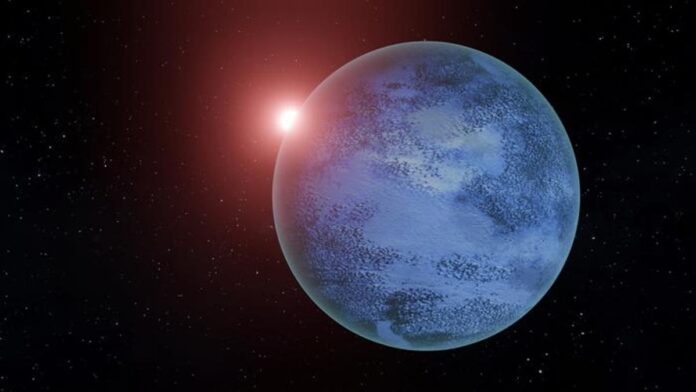There could be many more Earth -like planets hosting liquid water , increasing the odds of finding alien life outside the Solar System , a new analysis suggests. Even on a planet where conditions are not ideal for water to exist on the surface, there may still be liquid water under its surface, found the research presented at the Goldschmidt geochemistry conference in Lyon and published recently in the journal Nature Communications . ‘Our work shows that this water can be found in places we had not much considered. This significantly increases the chances of finding environments where life could, in theory, develop,’ said study co-author Lujendra Ojha from Rutgers University. Even if the surface of a planet is frozen, there are two main ways that enough heat can be generated to allow water to liquify underground. Citing an example, the researchers pointed to a time on Earth a few billion years ago, when the surface liquid water was completely frozen , but water on the planet was not completely solid everywhere. During this time in Earth’s history, the heat from radioactivity deep in the planet could warm water enough to keep it liquid in some places. ‘Even today, we see this happening in places like Antarctica and the Canadian Arctic, where despite the frigid temperature, there are large underground lakes of liquid water, sustained by the heat generated from radioactivity,’ Dr Ojha explained. ‘There is even some evidence to suggest that this might be even happening currently in the south pole of Mars ,’ he said. Scientists have previously found that even in the Solar System, some moons, such as Saturn ‘s Europa, have substantial underground liquid water even though their surfaces are completely frozen. This is due to their interior being continuously churned by the gravitational effects of the large planets they orbit. ‘This makes the moons of Jupiter and Saturn prime candidates for finding life in our Solar System and many future missions have been planned to explore these bodies,’ Dr Ojha said. In the new analysis, researchers looked at the planets found around the most common type of stars called M-dwarfs, which are small stars much colder than the Sun. About 70 per cent of stars in the Milky Way galaxy are M-dwarfs and most Earth-like exoplanets found to date orbit these stars. Scientists modelled the feasibility of generating and sustaining liquid water on such planets orbiting M-dwarfs by only considering the heat generated by the planet. ‘We found that when one considers the possibility of liquid water generated by radioactivity, it is likely that a high percentage of these exoplanets can have sufficient heat to sustain liquid water– many more than we had thought,’ Dr Ojha explained. Before the estimate, around one rocky planet for every 100 stars was thought to have liquid water. But the new model suggests that, under the right conditions, this could approach one planet per star. ‘So we are a hundred times more likely to find liquid water than we thought. There are around 100 billion stars in the Milky Way Galaxy. That represents really good odds for the origin of life elsewhere in the universe,’ Dr Ojha concluded.
Chance of finding water, alien life on other planets may be much greater than thought
Sourceindependent.co.uk
RELATED ARTICLES


